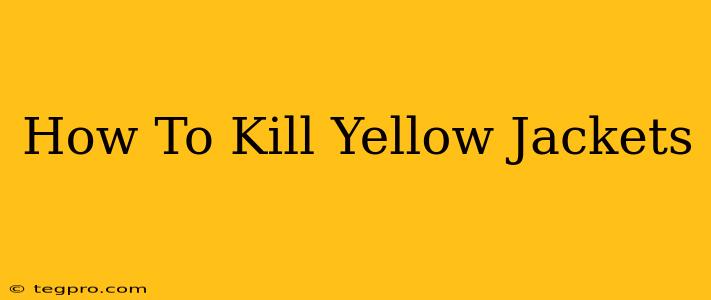Yellow jackets. Just the name conjures images of painful stings and unwelcome buzzing around your picnic. These aggressive wasps can quickly turn a fun outdoor gathering into a frantic retreat. But you don't have to live in fear! This comprehensive guide will equip you with the knowledge and strategies to effectively eliminate yellow jacket nests and prevent future infestations.
Understanding Yellow Jackets: Identifying the Threat
Before you launch into any eradication efforts, it's crucial to correctly identify the pest. Yellow jackets are social wasps, characterized by their distinctive black and yellow striped bodies. They're often confused with honeybees, but key differences include their slender bodies, aggressive nature, and tendency to build nests underground or in wall voids.
Identifying a Yellow Jacket Nest:
Yellow jacket nests are typically constructed of a papery material made from chewed wood fibers. They can vary greatly in size, ranging from the size of a golf ball to a large basketball, depending on the colony's age and population. Common locations include:
- Underground: Often found in abandoned rodent burrows or under decks and sheds.
- Wall voids: Nests can be built inside the walls of your home, making them difficult to detect.
- Attic spaces: Yellow jackets may build nests in attics or other enclosed areas.
- Tree cavities: Hollow trees can provide ideal nesting sites.
Safe and Effective Yellow Jacket Control Methods
Eliminating yellow jackets requires a cautious and strategic approach. Safety is paramount. Never attempt to remove a nest without proper protective gear.
1. Professional Pest Control: The Safest Option
For large or inaccessible nests, calling a professional pest control service is highly recommended. Professionals possess the expertise, equipment (like specialized suits and insecticides), and experience to safely and effectively remove nests, minimizing the risk of stings.
2. DIY Methods for Smaller Nests:
If the nest is small and accessible, you may consider a DIY approach. However, proceed with extreme caution and always wear protective clothing, including a long-sleeved shirt, long pants, gloves, and eye protection.
-
Insecticidal sprays: These are available at most hardware stores and garden centers. Follow the instructions carefully, aiming for the nest entrance at dusk or night when the yellow jackets are less active. Remember to maintain a safe distance.
-
Traps: Yellow jacket traps can be effective in reducing the population, especially for smaller nests or to prevent future infestations. These traps usually use bait to lure the wasps inside, where they are unable to escape. Place traps strategically near potential entry points.
3. Prevention: Keeping Yellow Jackets Away
Preventing yellow jackets from establishing nests in the first place is the best strategy. Consider these preventive measures:
- Eliminate food sources: Keep food and drinks covered, especially outdoors. Clean up spilled food and drinks immediately.
- Seal entry points: Repair cracks and gaps in your home's exterior to prevent yellow jackets from gaining access.
- Keep garbage cans tightly covered: This prevents yellow jackets from being attracted to food scraps.
- Regularly inspect your property: Check for signs of nests early in the season to address them before they become large and problematic.
Dealing with Stings: First Aid and Prevention
Even with the best prevention strategies, stings can happen. Here's what to do:
- Remove the stinger: If present (honeybees only leave stingers), carefully scrape it away with a credit card or your fingernail. Avoid squeezing it, as this can release more venom.
- Clean the area: Wash the affected area with soap and water.
- Apply a cold compress: This can help reduce swelling and pain.
- Over-the-counter pain relievers: Ibuprofen or acetaminophen can help manage pain and inflammation.
- Seek medical attention: If you experience an allergic reaction (difficulty breathing, swelling of the face or throat), seek immediate medical attention.
Remember: Safety is always the top priority when dealing with yellow jackets. If you are unsure about any aspect of yellow jacket control, it's best to consult with a professional pest control service. Don't risk a painful sting or a larger infestation by attempting to handle it alone if you lack the experience or proper equipment.

